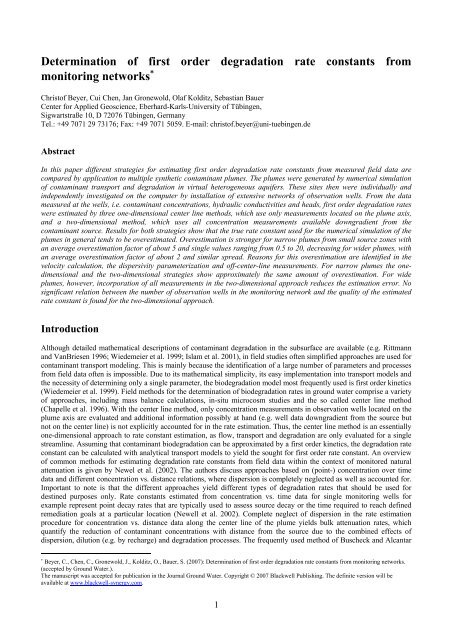Applied numerical modeling of saturated / unsaturated flow and ...
Applied numerical modeling of saturated / unsaturated flow and ...
Applied numerical modeling of saturated / unsaturated flow and ...
You also want an ePaper? Increase the reach of your titles
YUMPU automatically turns print PDFs into web optimized ePapers that Google loves.
Determination <strong>of</strong> first order degradation rate constants from<br />
monitoring networks ∗<br />
Christ<strong>of</strong> Beyer, Cui Chen, Jan Gronewold, Olaf Kolditz, Sebastian Bauer<br />
Center for <strong>Applied</strong> Geoscience, Eberhard-Karls-University <strong>of</strong> Tübingen,<br />
Sigwartstraße 10, D 72076 Tübingen, Germany<br />
Tel.: +49 7071 29 73176; Fax: +49 7071 5059. E-mail: christ<strong>of</strong>.beyer@uni-tuebingen.de<br />
Abstract<br />
In this paper different strategies for estimating first order degradation rate constants from measured field data are<br />
compared by application to multiple synthetic contaminant plumes. The plumes were generated by <strong>numerical</strong> simulation<br />
<strong>of</strong> contaminant transport <strong>and</strong> degradation in virtual heterogeneous aquifers. These sites then were individually <strong>and</strong><br />
independently investigated on the computer by installation <strong>of</strong> extensive networks <strong>of</strong> observation wells. From the data<br />
measured at the wells, i.e. contaminant concentrations, hydraulic conductivities <strong>and</strong> heads, first order degradation rates<br />
were estimated by three one-dimensional center line methods, which use only measurements located on the plume axis,<br />
<strong>and</strong> a two-dimensional method, which uses all concentration measurements available downgradient from the<br />
contaminant source. Results for both strategies show that the true rate constant used for the <strong>numerical</strong> simulation <strong>of</strong> the<br />
plumes in general tends to be overestimated. Overestimation is stronger for narrow plumes from small source zones with<br />
an average overestimation factor <strong>of</strong> about 5 <strong>and</strong> single values ranging from 0.5 to 20, decreasing for wider plumes, with<br />
an average overestimation factor <strong>of</strong> about 2 <strong>and</strong> similar spread. Reasons for this overestimation are identified in the<br />
velocity calculation, the dispersivity parameterization <strong>and</strong> <strong>of</strong>f-center-line measurements. For narrow plumes the onedimensional<br />
<strong>and</strong> the two-dimensional strategies show approximately the same amount <strong>of</strong> overestimation. For wide<br />
plumes, however, incorporation <strong>of</strong> all measurements in the two-dimensional approach reduces the estimation error. No<br />
significant relation between the number <strong>of</strong> observation wells in the monitoring network <strong>and</strong> the quality <strong>of</strong> the estimated<br />
rate constant is found for the two-dimensional approach.<br />
Introduction<br />
Although detailed mathematical descriptions <strong>of</strong> contaminant degradation in the subsurface are available (e.g. Rittmann<br />
<strong>and</strong> VanBriesen 1996; Wiedemeier et al. 1999; Islam et al. 2001), in field studies <strong>of</strong>ten simplified approaches are used for<br />
contaminant transport <strong>modeling</strong>. This is mainly because the identification <strong>of</strong> a large number <strong>of</strong> parameters <strong>and</strong> processes<br />
from field data <strong>of</strong>ten is impossible. Due to its mathematical simplicity, its easy implementation into transport models <strong>and</strong><br />
the necessity <strong>of</strong> determining only a single parameter, the biodegradation model most frequently used is first order kinetics<br />
(Wiedemeier et al. 1999). Field methods for the determination <strong>of</strong> biodegradation rates in ground water comprise a variety<br />
<strong>of</strong> approaches, including mass balance calculations, in-situ microcosm studies <strong>and</strong> the so called center line method<br />
(Chapelle et al. 1996). With the center line method, only concentration measurements in observation wells located on the<br />
plume axis are evaluated <strong>and</strong> additional information possibly at h<strong>and</strong> (e.g. well data downgradient from the source but<br />
not on the center line) is not explicitly accounted for in the rate estimation. Thus, the center line method is an essentially<br />
one-dimensional approach to rate constant estimation, as <strong>flow</strong>, transport <strong>and</strong> degradation are only evaluated for a single<br />
streamline. Assuming that contaminant biodegradation can be approximated by a first order kinetics, the degradation rate<br />
constant can be calculated with analytical transport models to yield the sought for first order rate constant. An overview<br />
<strong>of</strong> common methods for estimating degradation rate constants from field data within the context <strong>of</strong> monitored natural<br />
attenuation is given by Newel et al. (2002). The authors discuss approaches based on (point-) concentration over time<br />
data <strong>and</strong> different concentration vs. distance relations, where dispersion is completely neglected as well as accounted for.<br />
Important to note is that the different approaches yield different types <strong>of</strong> degradation rates that should be used for<br />
destined purposes only. Rate constants estimated from concentration vs. time data for single monitoring wells for<br />
example represent point decay rates that are typically used to assess source decay or the time required to reach defined<br />
remediation goals at a particular location (Newell et al. 2002). Complete neglect <strong>of</strong> dispersion in the rate estimation<br />
procedure for concentration vs. distance data along the center line <strong>of</strong> the plume yields bulk attenuation rates, which<br />
quantify the reduction <strong>of</strong> contaminant concentrations with distance from the source due to the combined effects <strong>of</strong><br />
dispersion, dilution (e.g. by recharge) <strong>and</strong> degradation processes. The frequently used method <strong>of</strong> Buscheck <strong>and</strong> Alcantar<br />
∗<br />
Beyer, C., Chen, C., Gronewold, J., Kolditz, O., Bauer, S. (2007): Determination <strong>of</strong> first order degradation rate constants from monitoring networks.<br />
(accepted by Ground Water.).<br />
The manuscript was accepted for publication in the Journal Ground Water. Copyright © 2007 Blackwell Publishing. The definite version will be<br />
available at www.blackwell-synergy.com.<br />
1

















